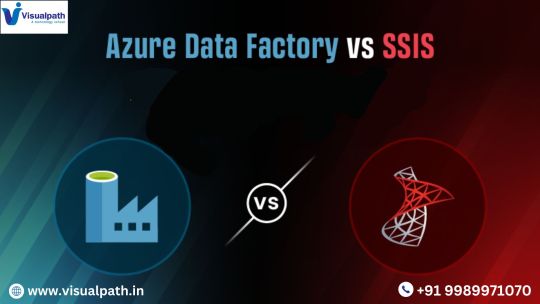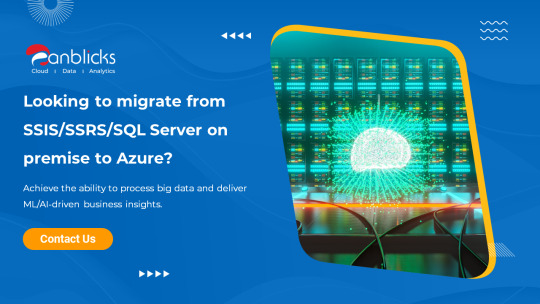#ssis to adf migration
Explore tagged Tumblr posts
Text
Exploring the Role of Azure Data Factory in Hybrid Cloud Data Integration

Introduction
In today’s digital landscape, organizations increasingly rely on hybrid cloud environments to manage their data. A hybrid cloud setup combines on-premises data sources, private clouds, and public cloud platforms like Azure, AWS, or Google Cloud. Managing and integrating data across these diverse environments can be complex.
This is where Azure Data Factory (ADF) plays a crucial role. ADF is a cloud-based data integration service that enables seamless movement, transformation, and orchestration of data across hybrid cloud environments.
In this blog, we’ll explore how Azure Data Factory simplifies hybrid cloud data integration, key use cases, and best practices for implementation.
1. What is Hybrid Cloud Data Integration?
Hybrid cloud data integration is the process of connecting, transforming, and synchronizing data between: ✅ On-premises data sources (e.g., SQL Server, Oracle, SAP) ✅ Cloud storage (e.g., Azure Blob Storage, Amazon S3) ✅ Databases and data warehouses (e.g., Azure SQL Database, Snowflake, BigQuery) ✅ Software-as-a-Service (SaaS) applications (e.g., Salesforce, Dynamics 365)
The goal is to create a unified data pipeline that enables real-time analytics, reporting, and AI-driven insights while ensuring data security and compliance.
2. Why Use Azure Data Factory for Hybrid Cloud Integration?
Azure Data Factory (ADF) provides a scalable, serverless solution for integrating data across hybrid environments. Some key benefits include:
✅ 1. Seamless Hybrid Connectivity
ADF supports over 90+ data connectors, including on-prem, cloud, and SaaS sources.
It enables secure data movement using Self-Hosted Integration Runtime to access on-premises data sources.
✅ 2. ETL & ELT Capabilities
ADF allows you to design Extract, Transform, and Load (ETL) or Extract, Load, and Transform (ELT) pipelines.
Supports Azure Data Lake, Synapse Analytics, and Power BI for analytics.
✅ 3. Scalability & Performance
Being serverless, ADF automatically scales resources based on data workload.
It supports parallel data processing for better performance.
✅ 4. Low-Code & Code-Based Options
ADF provides a visual pipeline designer for easy drag-and-drop development.
It also supports custom transformations using Azure Functions, Databricks, and SQL scripts.
✅ 5. Security & Compliance
Uses Azure Key Vault for secure credential management.
Supports private endpoints, network security, and role-based access control (RBAC).
Complies with GDPR, HIPAA, and ISO security standards.
3. Key Components of Azure Data Factory for Hybrid Cloud Integration
1️⃣ Linked Services
Acts as a connection between ADF and data sources (e.g., SQL Server, Blob Storage, SFTP).
2️⃣ Integration Runtimes (IR)
Azure-Hosted IR: For cloud data movement.
Self-Hosted IR: For on-premises to cloud integration.
SSIS-IR: To run SQL Server Integration Services (SSIS) packages in ADF.
3️⃣ Data Flows
Mapping Data Flow: No-code transformation engine.
Wrangling Data Flow: Excel-like Power Query transformation.
4️⃣ Pipelines
Orchestrate complex workflows using different activities like copy, transformation, and execution.
5️⃣ Triggers
Automate pipeline execution using schedule-based, event-based, or tumbling window triggers.
4. Common Use Cases of Azure Data Factory in Hybrid Cloud
🔹 1. Migrating On-Premises Data to Azure
Extracts data from SQL Server, Oracle, SAP, and moves it to Azure SQL, Synapse Analytics.
🔹 2. Real-Time Data Synchronization
Syncs on-prem ERP, CRM, or legacy databases with cloud applications.
🔹 3. ETL for Cloud Data Warehousing
Moves structured and unstructured data to Azure Synapse, Snowflake for analytics.
🔹 4. IoT and Big Data Integration
Collects IoT sensor data, processes it in Azure Data Lake, and visualizes it in Power BI.
🔹 5. Multi-Cloud Data Movement
Transfers data between AWS S3, Google BigQuery, and Azure Blob Storage.
5. Best Practices for Hybrid Cloud Integration Using ADF
✅ Use Self-Hosted IR for Secure On-Premises Data Access ✅ Optimize Pipeline Performance using partitioning and parallel execution ✅ Monitor Pipelines using Azure Monitor and Log Analytics ✅ Secure Data Transfers with Private Endpoints & Key Vault ✅ Automate Data Workflows with Triggers & Parameterized Pipelines
6. Conclusion
Azure Data Factory plays a critical role in hybrid cloud data integration by providing secure, scalable, and automated data pipelines. Whether you are migrating on-premises data, synchronizing real-time data, or integrating multi-cloud environments, ADF simplifies complex ETL processes with low-code and serverless capabilities.
By leveraging ADF’s integration runtimes, automation, and security features, organizations can build a resilient, high-performance hybrid cloud data ecosystem.
WEBSITE: https://www.ficusoft.in/azure-data-factory-training-in-chennai/
0 notes
Link
Anblicks helped one of the top five transportation and logistics companies in North America to lift & shift the existing ETL SSIS packages to ADF and architected the Power BI platform. Resulting in improved business outcomes with real-time insights.
2 notes
·
View notes
Text
Best Azure Data Engineer | Azure Data Engineer Course Online
Azure Data Factory vs SSIS: Understanding the Key Differences
Azure Data Factory (ADF) is a modern, cloud-based data integration service that enables organizations to efficiently manage, transform, and move data across various systems. In contrast, SQL Server Integration Services (SSIS) is a traditional on-premises ETL tool designed for batch processing and data migration. Both are powerful data integration tools offered by Microsoft, but they serve different purposes, environments, and capabilities. In this article, we’ll delve into the key differences between Azure Data Factory and SSIS, helping you understand when and why to choose one over the other. Microsoft Azure Data Engineer

1. Overview
SQL Server Integration Services (SSIS)
SSIS is a traditional on-premises ETL (Extract, Transform, Load) tool that is part of Microsoft SQL Server. It allows users to create workflows for data integration, transformation, and migration between various systems. SSIS is ideal for batch processing and is widely used for enterprise-scale data warehouse operations.
Azure Data Factory (ADF)
ADF is a cloud-based data integration service that enables orchestration and automation of data workflows. It supports modern cloud-first architectures and integrates seamlessly with other Azure services. ADF is designed for handling big data, real-time data processing, and hybrid environments.
2. Deployment Environment
SSIS: Runs on-premises or in virtual machines. While you can host SSIS in the Azure cloud using Azure-SSIS Integration Runtime, it remains fundamentally tied to its on-premises roots.
ADF: Fully cloud-native and designed for Azure. It leverages the scalability, reliability, and flexibility of cloud infrastructure, making it ideal for modern, cloud-first architectures. Azure Data Engineering Certification
3. Data Integration Capabilities
SSIS: Focuses on traditional ETL processes with strong support for structured data sources like SQL Server, Oracle, and flat files. It offers various built-in transformations and control flow activities. However, its integration with modern cloud and big data platforms is limited.
ADF: Provides a broader range of connectors, supporting over 90 on-premises and cloud-based data sources, including Azure Blob Storage, Data Lake, Amazon S3, and Google Big Query. ADF also supports ELT (Extract, Load, Transform), enabling transformations within data warehouses like Azure Synapse Analytics.
4. Scalability and Performance
SSIS: While scalable in an on-premises environment, SSIS’s scalability is limited by your on-site hardware and infrastructure. Scaling up often involves significant costs and complexity.
ADF: Being cloud-native, ADF offers elastic scalability. It can handle vast amounts of data and scale resources dynamically based on workload, providing cost-effective processing for both small and large datasets.
5. Monitoring and Management
SSIS: Includes monitoring tools like SSISDB and SQL Server Agent, which allow you to schedule and monitor package execution. However, managing SSIS in distributed environments can be complex.
ADF: Provides a centralized, user-friendly interface within the Azure portal for monitoring and managing data pipelines. It also offers advanced logging and integration with Azure Monitor, making it easier to track performance and troubleshoot issues. Azure Data Engineer Course
6. Cost and Licensing
SSIS: Requires SQL Server licensing, which can be cost-prohibitive for organizations with limited budgets. Running SSIS in Azure adds additional infrastructure costs for virtual machines and storage.
ADF: Operates on a pay-as-you-go model, allowing you to pay only for the resources you consume. This makes ADF a more cost-effective option for organizations looking to minimize upfront investment.
7. Flexibility and Modern Features
SSIS: Best suited for organizations with existing SQL Server infrastructure and a need for traditional ETL workflows. However, it lacks features like real-time streaming and big data processing.
ADF: Supports real-time and batch processing, big data workloads, and integration with machine learning models and IoT data streams. ADF is built to handle modern, hybrid, and cloud-native data scenarios.
8. Use Cases
SSIS: Azure Data Engineer Training
On-premises data integration and transformation.
Migrating and consolidating data between SQL Server and other relational databases.
Batch processing and traditional ETL workflows.
ADF:
Building modern data pipelines in cloud or hybrid environments.
Handling large-scale big data workloads.
Real-time data integration and IoT data processing.
Cloud-to-cloud or cloud-to-on-premises data workflows.
Conclusion
While both Azure Data Factory and SSIS are powerful tools for data integration, they cater to different needs. SSIS is ideal for traditional, on-premises data environments with SQL Server infrastructure, whereas Azure Data Factory is the go-to solution for modern, scalable, and cloud-based data pipelines. The choice ultimately depends on your organization’s infrastructure, workload requirements, and long-term data strategy.
By leveraging the right tool for the right use case, businesses can ensure efficient data management, enabling them to make informed decisions and gain a competitive edge.
Visualpath is the Best Software Online Training Institute in Hyderabad. Avail complete Azure Data Engineering worldwide. You will get the best course at an affordable cost.
Attend Free Demo
Call on - +91-9989971070.
Visit: https://www.visualpath.in/online-azure-data-engineer-course.html
WhatsApp: https://www.whatsapp.com/catalog/919989971070/
Visit Blog: https://azuredataengineering2.blogspot.com/
#Azure Data Engineer Course#Azure Data Engineering Certification#Azure Data Engineer Training In Hyderabad#Azure Data Engineer Training#Azure Data Engineer Training Online#Azure Data Engineer Course Online#Azure Data Engineer Online Training#Microsoft Azure Data Engineer
0 notes
Link

2 notes
·
View notes